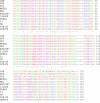Synthesis of gamma-aminobutyric acid by lactic acid bacteria isolated from a variety of Italian cheeses
- PMID: 17890341
- PMCID: PMC2168214
- DOI: 10.1128/AEM.01064-07
Synthesis of gamma-aminobutyric acid by lactic acid bacteria isolated from a variety of Italian cheeses
Abstract
The concentrations of gamma-aminobutyric acid (GABA) in 22 Italian cheese varieties that differ in several technological traits markedly varied from 0.26 to 391 mg kg(-1). Presumptive lactic acid bacteria were isolated from each cheese variety (total of 440 isolates) and screened for the capacity to synthesize GABA. Only 61 isolates showed this activity and were identified by partial sequencing of the 16S rRNA gene. Twelve species were found. Lactobacillus paracasei PF6, Lactobacillus delbrueckii subsp. bulgaricus PR1, Lactococcus lactis PU1, Lactobacillus plantarum C48, and Lactobacillus brevis PM17 were the best GABA-producing strains during fermentation of reconstituted skimmed milk. Except for L. plantarum C48, all these strains were isolated from cheeses with the highest concentrations of GABA. A core fragment of glutamate decarboxylase (GAD) DNA was isolated from L. paracasei PF6, L. delbrueckii subsp. bulgaricus PR1, L. lactis PU1, and L. plantarum C48 by using primers based on two highly conserved regions of GAD. A PCR product of ca. 540 bp was found for all the strains. The amino acid sequences deduced from nucleotide sequence analysis showed 98, 99, 90, and 85% identity to GadB of L. plantarum WCFS1 for L. paracasei PF6, L. delbrueckii subsp. bulgaricus PR1, L. lactis PU1, and L. plantarum C48, respectively. Except for L. lactis PU1, the three lactobacillus strains survived and synthesized GABA under simulated gastrointestinal conditions. The findings of this study provide a potential basis for exploiting selected cheese-related lactobacilli to develop health-promoting dairy products enriched in GABA.
Figures




Similar articles
-
Diversity and dynamics of lactobacilli populations during ripening of RDO Camembert cheese.Can J Microbiol. 2008 Mar;54(3):218-28. doi: 10.1139/w07-137. Can J Microbiol. 2008. PMID: 18388993
-
Cloning, sequencing and expression of a novel glutamate decarboxylase gene from a newly isolated lactic acid bacterium, Lactobacillus brevis OPK-3.Bioresour Technol. 2007 Jan;98(2):312-9. doi: 10.1016/j.biortech.2006.01.004. Epub 2006 Feb 24. Bioresour Technol. 2007. PMID: 16500100
-
GABA production and structure of gadB/gadC genes in Lactobacillus and Bifidobacterium strains from human microbiota.Anaerobe. 2016 Dec;42:197-204. doi: 10.1016/j.anaerobe.2016.10.011. Epub 2016 Oct 26. Anaerobe. 2016. PMID: 27794467
-
The Microfloras and Sensory Profiles of Selected Protected Designation of Origin Italian Cheeses.Microbiol Spectr. 2014 Feb;2(1):CM-0007-2012. doi: 10.1128/microbiolspec.CM-0007-2012. Microbiol Spectr. 2014. PMID: 26082116 Review.
-
Microbial gamma-aminobutyric acid synthesis: a promising approach for functional food and pharmaceutical applications.Lett Appl Microbiol. 2024 Dec 2;77(12):ovae122. doi: 10.1093/lambio/ovae122. Lett Appl Microbiol. 2024. PMID: 39673306 Review.
Cited by
-
Evaluation of commercial soy sauce koji strains of Aspergillus oryzae for γ-aminobutyric acid (GABA) production.J Ind Microbiol Biotechnol. 2016 Oct;43(10):1387-95. doi: 10.1007/s10295-016-1828-5. Epub 2016 Aug 19. J Ind Microbiol Biotechnol. 2016. PMID: 27541157
-
A Brief Review on the Non-protein Amino Acid, Gamma-amino Butyric Acid (GABA): Its Production and Role in Microbes.Curr Microbiol. 2020 Apr;77(4):534-544. doi: 10.1007/s00284-019-01839-w. Epub 2019 Dec 16. Curr Microbiol. 2020. PMID: 31844936 Review.
-
The Enteric Network: Interactions between the Immune and Nervous Systems of the Gut.Immunity. 2017 Jun 20;46(6):910-926. doi: 10.1016/j.immuni.2017.05.011. Immunity. 2017. PMID: 28636959 Free PMC article. Review.
-
Biochemical Features of Beneficial Microbes: Foundations for Therapeutic Microbiology.Microbiol Spectr. 2017 Oct;5(5):10.1128/microbiolspec.bad-0012-2016. doi: 10.1128/microbiolspec.BAD-0012-2016. Microbiol Spectr. 2017. PMID: 28984235 Free PMC article. Review.
-
Investigations on Metabolic Changes in Beagle Dogs Fed Probiotic Queso Blanco Cheese and Identification of Candidate Probiotic Fecal Biomarkers Using Metabolomics Approaches.Metabolites. 2020 Jul 25;10(8):305. doi: 10.3390/metabo10080305. Metabolites. 2020. PMID: 32722505 Free PMC article.
References
-
- Adeghate, E., and A. S. Ponery. 2002. GABA in the endocrine pancreas: cellular localization and function in normal and diabetic rats. Tissue Cell 34:1-6. - PubMed
-
- Aoki, H., Y. Furuya, Y. Endo, and K. Fujimoto. 2003. Effect of gamma-aminobutyric acid-enriched tempeh-like fermented soybean (GABA- tempeh) on the blood pressure of spontaneously hypertensive rats. Biosci. Biotechnol. Biochem. 67:1806-1808. - PubMed
-
- Chou, L., and B. Weimer. 1999. Isolation and characterization of acid- and bile-tolerant isolates from strains of Lactobacillus acidophilus. J. Dairy Sci. 82:23-31. - PubMed
MeSH terms
Substances
Associated data
- Actions
- Actions
- Actions
- Actions
LinkOut - more resources
Full Text Sources
Other Literature Sources
Molecular Biology Databases

